Translate Page

A new bilingual production at Playwrights Horizons is performed in English and American Sign Language
---
Craig Lucas' new play I Was Most Alive with You at Playwrights Horizons is about a family coping with a series of calamities that recall the biblical story of Job. But ask Sabrina Dennison to describe the show and she declares it's "complicated." She says this in American Sign Language (ASL) because that is her first language, but she doesn't use the traditional sign of wiggling her index fingers while crossing her arms. Instead, she wiggles all ten digits -- that's how complicated it's been.
Dennison is the director of artistic sign language for the production, which is performed in English and ASL by 14 actors divided into two casts playing the same seven roles. The cast on stage primarily speaks; the other signs simultaneously from a balcony above. Since some of the characters are deaf, sometimes the speaking cast signs as supertitles are projected on a screen for those who don't know ASL. (After opening night on September 24, the theatre will also offer synchronized captions on smartphones via the accessibility app GalaPro, the first time the service has been available Off-Broadway.) Ultimately, the show's goal is to be totally accessible to both deaf and hearing audiences.
While the artists put the production together in less than two months, director Tyne Rafaeli admits it was tough. How long would have been ideal? "Ten years!" she says. "It's been enormously challenging and complicated. It is also very deep and important. The play is about how we tell the story of our lives -- what language we use, how we struggle to communicate. Having people on different levels in different languages is a lot for the human brain to take in. The audience has to work hard -- and I don't think that is a bad thing."
The narrative, which flits back and forth in time, is almost as complex as its execution. Ash and Astrid are writing partners on a hit TV series who want to launch a new show inspired by the Book of Job. They use Ash's tragic family history as creative fodder, including incidents involving his son, Knox, who is gay, deaf and a recovering addict. When Knox brings home Farhad, who is also deaf but is an active drug user, Ash worries his son's life is going off the rails. Indeed, many misfortunes befall the characters, including a terrible accident.
"It was my fault," says Tad Cooley as Farhad at a climactic moment on stage while Anthony Natale as Farhad forcefully signs the same line from the balcony. Like the other pairs of actors, the Farhads work hard to make sure their performances stay in sync. That's not an easy task since the so-called "shadow cast" can't hear their speaking counterparts and sometimes can't even see them due to blocking. Instead, they rely on vibrations, lighting or body movements as cues.
For the first two weeks of rehearsals, the actors sat in a circle for table reads, so each could interact not just with his or her double, but all the performers. "That's when the two casts began to come together as one," signs Dennison.
"I watched his breathing, his emotions, his energy," Natale signs about Cooley, explaining how they learned to work together to create their character. "We're not just interpreting, we're part of the story," Natale adds, noting that the members of the shadow cast are professional actors, too.
While other shows like Deaf West's Spring Awakening have used speaking and signing casts simultaneously, Rafaeli believes the specific two-tier technique they have been developing for I Was Most Alive with You is unique and could be employed in future productions "but it needs to be refined," she admits. "We will continue to learn and improve. We have changed a lot and we are now in a really good place."
But there's still more to do.
"It's a W.I.P.," Dennison signs. "A work in progress."
To read about a student's experience at I Was Most Alive with You, check out this post on TDF's sister site SEEN.
---
Jonathan Mandell is a drama critic and journalist based in New York. Visit his blog at NewYorkTheater.me or follow him on Twitter at @NewYorkTheater. Follow TDF at @TDFNYC.
Top image: Russell Harvard and Tad Cooley in I Was Most Alive with You. Photos by Joan Marcus.
TDF MEMBERS: Go here to browse our latest discounts for dance, theatre and concerts.